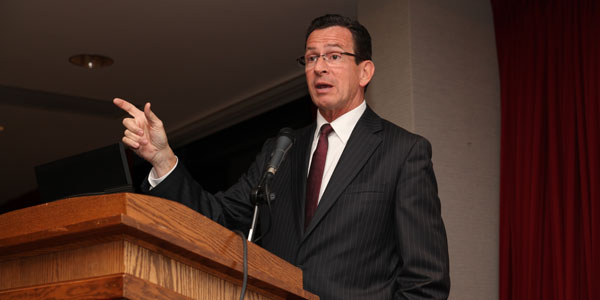Malloy budget address seeks to narrow $1.7 billion gap
How do you overcome a $1.7 billion deficit? If you”™re Gov. Dannel Malloy, you offer up $1.36 billion in new spending reductions, seek $700 million in annual state employee labor savings, lower the tax rate on insurance premiums from 1.75 percent to 1.5 percent and ask Connecticut”™s municipalities to contribute one-third of the cost toward their teacher pensions.
And, although he didn”™t say it during his Fiscal Year 2018/2019 biennial budget proposal to the state legislature on Feb. 8, you also probably hope for the best.
 Malloy is calling for a two-year budget that does not make adjustments to any major tax rates, stays within the spending cap and grows at a pace well below inflation. If passed as is, it would keep the state budget at an eight-year growth rate of 2 percent, compared with the previous eight years that grew at a rate of 4.8 percent; make required increased contributions to the state”™s pension systems of more than $357 million; and create a municipal accountability system designed to provide state intervention and support to local governments confronting fiscal challenges.
Malloy is calling for a two-year budget that does not make adjustments to any major tax rates, stays within the spending cap and grows at a pace well below inflation. If passed as is, it would keep the state budget at an eight-year growth rate of 2 percent, compared with the previous eight years that grew at a rate of 4.8 percent; make required increased contributions to the state”™s pension systems of more than $357 million; and create a municipal accountability system designed to provide state intervention and support to local governments confronting fiscal challenges.
In his address, the governor gave particular emphasis to the relationship between the state and its municipalities. “The truth is that, for too long, we”™ve allowed certain communities to be disproportionately impacted by the state”™s fiscal challenges,” he said. “Disparities have persisted and grown over the years, creating large pockets of concentrated poverty where communities sometimes sacrifice education for services ”“ or services for education ”“ or both.
“The result,” he added, “is a broken, disparate system where towns are pitted against one another, constantly fighting for limited state dollars.”
That is a situation that the administration has certainly contributed to, as evidenced by Malloy”™s sudden announcement on Dec. 29 that $50 million in new reductions in state aid to municipalities, including $20 million in cuts to education cost-sharing grants, were being made; the education aid cut came on top of an $84 million reduction to education announced in 2015.
“At more than $5 billion, municipal aid accounts for our single largest state expenditure,” the governor stated. “And addressing town aid also means that we are addressing educational aid, which amounts to $4.1 billion ”“ or 81 percent ”“ of all municipal funding from the state.”
Saying that Connecticut is failing to meet its constitutional requirement of a fair and equitable public education system, Malloy proposed updating the educational cost-sharing formula designed to recognize shifting demographics in small towns and growing cities, and use a more accurate measure of wealth to allow the state to better direct its support to communities with higher concentrations of poverty.
Absent from the governor”™s address was any mention of the state of Connecticut”™s health care, beyond noting that people “should be able to ”¦ afford health care.” The speech”™s other two invocations of “health” were in the context of “fiscal health.”
However, within the budget, some 9,500 people would no longer qualify for Medicaid as the income limit for parents of minor children would increase from 155 percent of the poverty level to 138 percent. In addition, $4.7 million would be cut to grants for mental health and substance abuse services.
Those eligible for both Medicare and Medicaid will also pay more for prescription drugs if the budget is passed; while Connecticut caps co-pays at $17 per month, the new budget would remove that cap. Dental coverage for adults enrolled in Medicaid would be capped at $1,000 per year per person.
“This budget erodes the programs, from prescription drugs to nutrition programs and more, which make it possible for seniors to afford to stay at home and avoid more costly institutional care,” said AARP Connecticut in a statement. “It also further financially strains family caregivers who are spending an average of nearly 20 percent of their income providing care for a family member or other loved one.”
Among other key points, Malloy seeks to:
- Increase funding for special education by $10 million and make it a separate formula grant from education cost sharing to provide more transparency in the actual costs and encourage school systems to seek Medicaid reimbursement where available.
- Include substantial state mandate relief for towns and cities across the state, providing municipalities with greater flexibility and additional tools for making local government leaner and more cost-efficient.
- Create a municipal accountability system designed to provide state intervention and support to local governments confronting fiscal challenges.
- Help the Connecticut Department of Housing fulfill its mission of matching every chronically homeless person to permanent housing, something that no state to date has accomplished.
Achieving many of those objectives may prove difficult. Unionized state employees”™ willingness to provide wage and benefit concessions worth $700 million this fiscal year and $800 million in 2018-19 seems unlikely, while towns willing ”“ or indeed able ”“ to go from providing nothing to 33.3 percent of the cost of its teachers”™ pensions may be hard to find, especially in light of the recent, unexpected cuts in state aid.
There is also the makeup of the state legislature to consider: With 18 Democrats and 18 Republicans in the Senate, and a narrow 79-72 Democratic majority in the House, Malloy will need to rely on a general spirit of bipartisan cooperation to get his budget approved. Lingering bad memories of the battle over the last budget could prove to be a negative or positive this year.